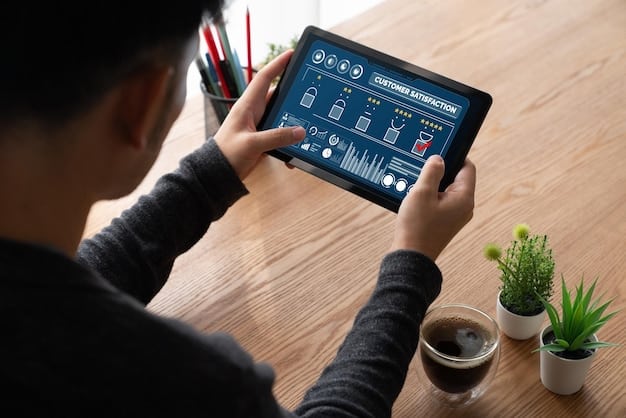The Future of Customer Experience: Trends & Predictions for 2025+

The future of customer experience (CX) will be shaped by personalization, AI-driven interactions, omnichannel consistency, data privacy, and immersive technologies, creating more seamless and valuable customer journeys.
The world of customer experience is constantly evolving, and understanding **what is the future of customer experience? Predictions and Trends for 2025 and Beyond** is crucial for businesses aiming to stay ahead. This article explores the key trends and predictions shaping the future of CX, providing insights for businesses to adapt and thrive.
The Rise of Hyper-Personalization
Hyper-personalization is set to redefine customer interactions, moving beyond basic customization to create truly tailored experiences. By leveraging data insights and advanced analytics, companies can anticipate individual needs and preferences, offering unparalleled levels of relevance and engagement.
This approach not only enhances customer satisfaction but also drives loyalty and advocacy, as customers feel valued and understood on a personal level.
Data-Driven Personalization
Data is the backbone of hyper-personalization, providing the insights needed to understand customer behavior and preferences.
AI-Powered Recommendations
Artificial intelligence plays a crucial role in analyzing data and generating personalized recommendations for customers.
- Predictive analytics will anticipate customer needs based on past behavior.
- AI-driven chatbots will offer personalized support and guidance.
- Real-time personalization will adapt to customer interactions on the fly.
- Personalized content delivery ensures customers receive the most relevant information.
In summary, hyper-personalization is reshaping customer interactions, offering tailored experiences through data and AI, resulting in enhanced satisfaction and enduring loyalty.

AI and Automation in Customer Service
AI and automation are revolutionizing customer service, enabling faster response times, personalized interactions, and efficient issue resolution. By implementing intelligent chatbots, virtual assistants, and automated workflows, businesses can enhance customer satisfaction while streamlining operations.
This transformation not only improves the customer experience but also empowers human agents to focus on complex and nuanced issues.
Chatbots and Virtual Assistants
Chatbots and virtual assistants are becoming increasingly sophisticated, offering seamless and personalized support.
Automated Workflows
Automated workflows streamline customer service operations, enabling faster and more efficient issue resolution.
- Intelligent routing directs inquiries to the most appropriate agent or resource.
- Automated self-service portals empower customers to find answers independently.
- Proactive alerts notify customers of potential issues before they escalate.
- Automated feedback collection provides valuable insights for continuous improvement.
In conclusion, integrating AI and automation into customer service elevates efficiency, offers personalized support, and empowers human agents to handle complex customer issues effectively.
The Omnichannel Experience: Seamless Integration
The omnichannel experience focuses on providing a seamless and consistent journey across all touchpoints. Whether customers interact online, in-store, or through mobile devices, they expect a unified and personalized experience.
This approach requires businesses to integrate their systems, data, and processes to ensure a cohesive and frictionless customer journey.
Unified Customer Profiles
Unified customer profiles are essential for delivering consistent experiences across all channels.
Consistent Branding and Messaging
Maintaining consistent branding and messaging across all channels reinforces brand identity and builds trust.

- Personalized content adapts to the customer’s preferred channel and device.
- Real-time data synchronization ensures agents have the latest customer information.
- Seamless transitions between channels allow customers to pick up where they left off.
- Integrated feedback loops capture customer insights from all touchpoints.
In essence, the omnichannel experience ensures seamless, personalized customer journeys across all touchpoints, reinforcing brand identity and building trust.
Data Privacy and Security: Building Trust
As data becomes increasingly central to customer experience, data privacy and security are paramount. Customers are more aware than ever of how their data is being used, and they expect businesses to handle their information responsibly and ethically.
Companies that prioritize data privacy and security not only build trust but also gain a competitive advantage in the market.
Transparent Data Practices
Transparency in data practices is essential for building trust with customers.
Robust Security Measures
Implementing robust security measures protects customer data from breaches and unauthorized access.
- Encryption technologies safeguard sensitive data both in transit and at rest.
- Regular security audits identify and address potential vulnerabilities.
- Compliance with data privacy regulations ensures ethical data handling.
- Customer consent mechanisms empower individuals to control their data.
In summary, prioritizing data privacy and security builds trust with customers, safeguards sensitive data, and ensures ethical handling in compliance with privacy regulations.
Immersive Technologies: Augmented and Virtual Reality
Immersive technologies like augmented reality (AR) and virtual reality (VR) are poised to transform customer experience, offering new and engaging ways to interact with products and services. From virtual try-ons to immersive product demos, AR and VR can enhance engagement and drive customer loyalty.
Businesses that embrace these technologies can create memorable and differentiated experiences that set them apart from the competition.
Augmented Reality Experiences
Augmented reality enhances the real world with digital overlays, creating engaging and interactive experiences.
Virtual Reality Environments
Virtual reality creates fully immersive digital environments, offering unparalleled levels of engagement.
- Virtual product demos allow customers to experience products remotely.
- Interactive training simulations enhance learning and skill development.
- Virtual tours offer immersive exploration of locations and facilities.
- Personalized virtual experiences cater to individual preferences and needs.
In conclusion, embracing immersive technologies like AR and VR transforms customer experience, offering engaging interactions, remote product experiences, and tailored virtual environments.
The Human Touch: Balancing Technology with Empathy
While technology plays an increasingly important role in customer experience, the human touch remains essential. Customers value empathy, understanding, and personalized attention, particularly when dealing with complex or emotional issues.
Businesses that strike the right balance between technology and human interaction can create truly exceptional experiences that foster loyalty and advocacy.
Empathetic Customer Service
Empathetic customer service focuses on understanding and addressing customer emotions and needs.
Personalized Human Interactions
Personalized human interactions create meaningful connections with customers.
- Trained agents exhibit active listening and problem-solving skills.
- Personalized follow-ups demonstrate care and attention to detail.
- Empathy-driven communication builds rapport and trust.
- Human agents handle complex and nuanced customer issues effectively.
In summary, balancing technology with empathy in customer service is crucial, enabling understanding, personalized attention, meaningful connections, and effective resolution of complex issues.
| Key Trend | Brief Description |
|---|---|
| ✨ Hyper-Personalization | Tailored experiences through data and AI, enhancing satisfaction and loyalty. |
| 🤖 AI & Automation | Efficient, personalized customer service with AI-powered chatbots and virtual assistants. |
| 🛡️ Data Privacy | Building customer trust with transparent and secure data handling practices. |
| 🌐 Omnichannel Experience | Seamless and consistent customer journey across all channels and touchpoints. |
FAQ
▼
Hyper-personalization is creating highly tailored customer experiences by leveraging data insights and advanced analytics to anticipate individual needs and preferences, offering unparalleled levels of relevance and engagement.
▼
AI enhances customer service by enabling faster response times, personalized interactions, and efficient issue resolution through intelligent chatbots, virtual assistants, and automated workflows, improving overall customer satisfaction.
▼
Data privacy is crucial for building customer trust. Customers expect businesses to handle their data responsibly and ethically. Companies that prioritize data privacy gain a competitive advantage in the market.
▼
Immersive technologies like augmented reality (AR) and virtual reality (VR) offer new and engaging ways to interact with products and services. They enhance engagement, drive customer loyalty, and create differentiated experiences.
▼
Businesses can balance technology with the human touch by focusing on empathetic customer service, personalized human interactions, and trained agents. This creates exceptional experiences that foster loyalty and advocacy.
Conclusion
As we look to 2025 and beyond, the future of customer experience will be shaped by hyper-personalization, AI-driven interactions, omnichannel consistency, data privacy, and immersive technologies. Businesses that embrace these trends and prioritize the human touch will be best positioned to create exceptional experiences that drive loyalty and advocacy.





